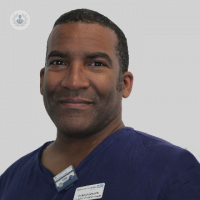Prostate seed (LDR) brachytherapy: the advantages of this prostate cancer treatment
Written by:Previously, highly-esteemed consultant clinical oncologist Dr Albert Edwards, explained what prostate seed or LDR brachytherapy is, how it differs from other brachytherapy treatments for prostate cancer, and how long the seeds remain active once inserted. In his second article in a two-part series, the Canterbury and Maidstone-based consultant looks at who is suitable for this treatment, what risks are involved, and what recovery typically looks like.

When is LDR brachytherapy recommended? What advantages does it have over other forms of treatment for prostate cancer?
Factors that determine whether someone is a suitable candidate for prostate cancer are the characteristics of prostate cancer, the physical characteristics of their prostate, and whether they have severe urinary symptoms that need to be improved.
Firstly, cancer must be restricted to the prostate, so, patients with stage T1 or T2 (early stages). Patients with T3A disease aren’t suitable and these are patients for whom there is evidence that the cancer has reached outside the capsule of the prostate. Careful studies have shown that when patients with T3A are operated on, often microscopic cancer cells can be seen a few millimetres just outside the prostate. LDR brachytherapy is advantageous because the radiation dose falls off rapidly to a very low level as you move outside of the prostate, leaving a risk that those cancer cells outside the prostate wouldn't be safely covered by the radiation from a brachytherapy implant.
The physical size of the prostate shouldn’t be too big. If the prostate becomes bigger than 60 millilitres in volume, the front part of the prostate hides behind the public bone. Unless we can reach the entire prostate with the needles that we use to put the radioactive seeds in, we won’t be able to treat the whole prostate properly.
Finally, a lot of patients who are found to have prostate cancer will have a history of having a problem with their waterworks; frequent urination during the day, having to get up at night to urinate, and having a weak stream of urine, along with other such symptoms. It is really important that those symptoms are treated and improved. The patient should have good urinary function before the brachytherapy implant is inserted. Short-term side-effects patients can suffer include exacerbation of urinary symptoms and if you leave these symptoms untreated, they can get even worse. It’s not pleasant and completely avoidable.
Are there any risks or side effects?
We normally do prostate seed brachytherapy implants under a general anaesthetic. Some patients may require a spinal anaesthetic if the anaesthetist thinks it is suitable. We take an hour to an hour and a half to do the procedure. When the patient wakes up, they’ll experience some discomfort in the perineum (the skin between the scrotum and anus) where the needles are inserted to deposit the seeds. There can be bleeding, bruising of the prostate, blood in the urine or semen, or blood from the back passage following the implant.

Also, there can be an increase in urinary symptoms in the weeks following the implant. Usually, side effects are at their worst four-to-six weeks following implantation and then they will resolve. These include a weaker stream of urine, a burning sensation when emptying the bladder, getting up to pee frequently during the night, or going more frequently during the day. The dose to the front wall of the back passage can upset the bowel and cause more wind, looser stools, and a more urgent need to empty the bowels.
Additionally, the nerves of the penis can be bruised by the needles or the radiation dose, so there is a small risk of impairment of erectile function. Although, of the three most common prostate cancer treatments (radiotherapy, surgery, and brachytherapy), brachytherapy is associated with the lowest risk of erectile dysfunction.
Patients normally recover quickly after a brachytherapy implant and are back to work within a week or two. It can be difficult to predict, so I recommend patients take a couple of weeks off. Most of my patients are quite surprised at how well they tolerate an implant and by how quickly they recover.
What is the recovery period like after this type of treatment?
I perform brachytherapy implantation as a day case; the patient comes in in the morning, on an empty stomach, ready to have a general anaesthetic. We put a catheter into the bladder and we do the procedure. Once it's done, the patient will remain in our care, as the anaesthetic wears off and to make sure the patient is peeing normally. They will then be taken home, as they won’t be able to drive due to the general anaesthetic on that day. Most patients will take a few days off, up to a week or two, before they get back to normal life. Apart from the radiation protection issues, there aren’t any particular precautions they need to take.
The follow-up is in two parts. Firstly, we do a prostate-specific antigen (PSA) test every three months and the PSA should continue to fall and will typically reach its lowest point typically 18 months following the implantation. Secondly, the patient’s side effects will be monitored. The reason for both is to monitor the patient and to see if their cancer has come back, to deal with any long or short-term symptoms they might have developed, and to answer any questions they might have.
If you would like to find out more about seed (LDR) brachytherapy or would like to discuss your options further, book a consultation with Dr Albert Edwards today via his Top Doctors profile.


